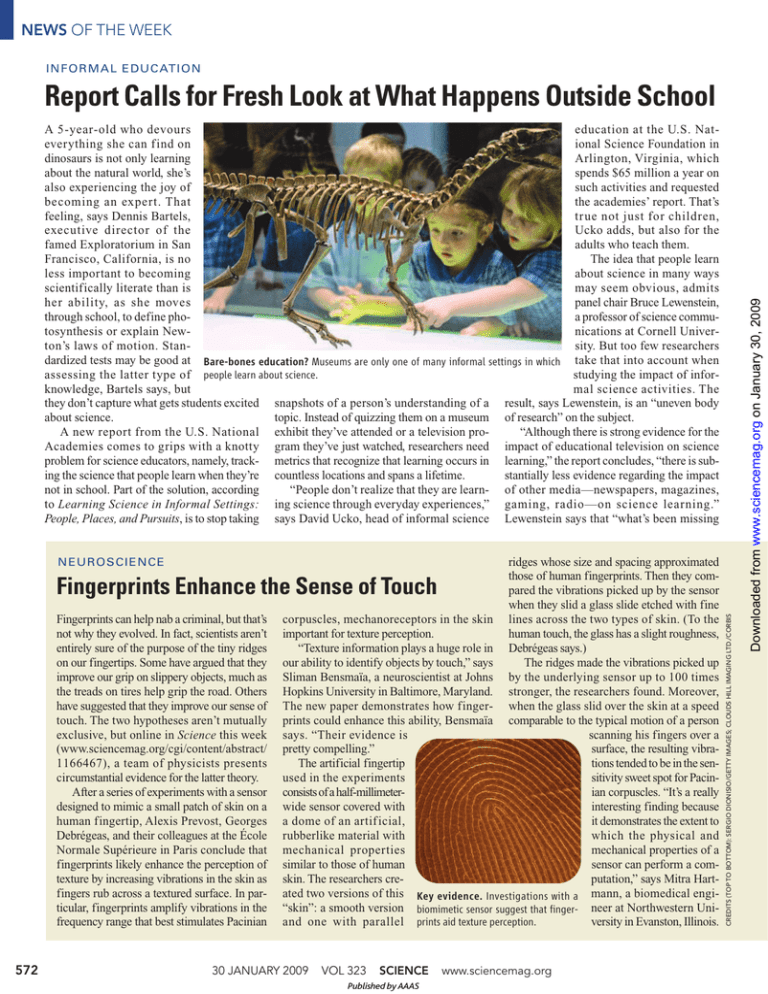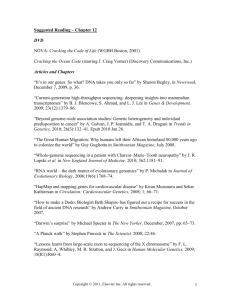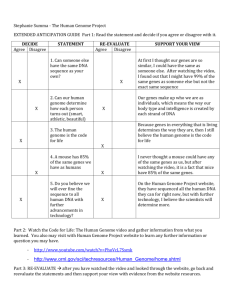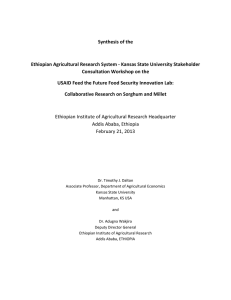Report Calls for Fresh Look at What Happens Outside School
advertisement

NEWS OF THE WEEK INFORMAL EDUCATION A 5-year-old who devours education at the U.S. Nateverything she can f ind on ional Science Foundation in dinosaurs is not only learning Arlington, Virginia, which about the natural world, she’s spends $65 million a year on also experiencing the joy of such activities and requested becoming an expert. That the academies’ report. That’s feeling, says Dennis Bartels, true not just for children, executive director of the Ucko adds, but also for the famed Exploratorium in San adults who teach them. Francisco, California, is no The idea that people learn less important to becoming about science in many ways scientifically literate than is may seem obvious, admits her ability, as she moves panel chair Bruce Lewenstein, through school, to define phoa professor of science commutosynthesis or explain Newnications at Cornell Univerton’s laws of motion. Stansity. But too few researchers dardized tests may be good at Bare-bones education? Museums are only one of many informal settings in which take that into account when assessing the latter type of people learn about science. studying the impact of inforknowledge, Bartels says, but mal science activities. The they don’t capture what gets students excited snapshots of a person’s understanding of a result, says Lewenstein, is an “uneven body about science. topic. Instead of quizzing them on a museum of research” on the subject. A new report from the U.S. National exhibit they’ve attended or a television pro“Although there is strong evidence for the Academies comes to grips with a knotty gram they’ve just watched, researchers need impact of educational television on science problem for science educators, namely, track- metrics that recognize that learning occurs in learning,” the report concludes, “there is subing the science that people learn when they’re countless locations and spans a lifetime. stantially less evidence regarding the impact not in school. Part of the solution, according “People don’t realize that they are learn- of other media—newspapers, magazines, to Learning Science in Informal Settings: ing science through everyday experiences,” gaming, radio—on science learning.” People, Places, and Pursuits, is to stop taking says David Ucko, head of informal science Lewenstein says that “what’s been missing NEUROSCIENCE ridges whose size and spacing approximated those of human fingerprints. Then they compared the vibrations picked up by the sensor when they slid a glass slide etched with fine corpuscles, mechanoreceptors in the skin lines across the two types of skin. (To the important for texture perception. human touch, the glass has a slight roughness, “Texture information plays a huge role in Debrégeas says.) our ability to identify objects by touch,” says The ridges made the vibrations picked up Sliman Bensmaïa, a neuroscientist at Johns by the underlying sensor up to 100 times Hopkins University in Baltimore, Maryland. stronger, the researchers found. Moreover, The new paper demonstrates how finger- when the glass slid over the skin at a speed prints could enhance this ability, Bensmaïa comparable to the typical motion of a person says. “Their evidence is scanning his fingers over a pretty compelling.” surface, the resulting vibraThe artificial fingertip tions tended to be in the senused in the experiments sitivity sweet spot for Pacinconsists of a half-millimeterian corpuscles. “It’s a really wide sensor covered with interesting finding because a dome of an artif icial, it demonstrates the extent to rubberlike material with which the physical and mechanical properties mechanical properties of a similar to those of human sensor can perform a comskin. The researchers creputation,” says Mitra Hartated two versions of this Key evidence. Investigations with a mann, a biomedical engi“skin”: a smooth version biomimetic sensor suggest that finger- neer at Northwestern Uniand one with parallel prints aid texture perception. versity in Evanston, Illinois. Fingerprints can help nab a criminal, but that’s not why they evolved. In fact, scientists aren’t entirely sure of the purpose of the tiny ridges on our fingertips. Some have argued that they improve our grip on slippery objects, much as the treads on tires help grip the road. Others have suggested that they improve our sense of touch. The two hypotheses aren’t mutually exclusive, but online in Science this week (www.sciencemag.org/cgi/content/abstract/ 1166467), a team of physicists presents circumstantial evidence for the latter theory. After a series of experiments with a sensor designed to mimic a small patch of skin on a human fingertip, Alexis Prevost, Georges Debrégeas, and their colleagues at the École Normale Supérieure in Paris conclude that fingerprints likely enhance the perception of texture by increasing vibrations in the skin as fingers rub across a textured surface. In particular, fingerprints amplify vibrations in the frequency range that best stimulates Pacinian 572 30 JANUARY 2009 VOL 323 SCIENCE Published by AAAS www.sciencemag.org CREDITS (TOP TO BOTTOM): SERGIO DIONISIO/GETTY IMAGES; CLOUDS HILL IMAGING LTD./CORBIS Fingerprints Enhance the Sense of Touch Downloaded from www.sciencemag.org on January 30, 2009 Report Calls for Fresh Look at What Happens Outside School NEWS OF THE WEEK CREDIT: COURTESY OF ANDREW PATERSON –JEFFREY MERVIS Selecting and amplifying the signals important for texture perception could in principle be accomplished within the nervous system, Hartmann says. But in this case, it seems to be the design of the hardware rather than the programming of the neural software that does the trick. The new results leave open why human fingerprints are arranged in elliptical swirls. Bensmaïa notes that the amplification effect was strongest when the textured glass slid perpendicular to the ridges, so it’s possible that the loops ensure that no matter how the fingers move, some ridges are always optimally oriented. It’s puzzling, however, that macaque monkeys have ridges parallel to the long axis of their fingers, Bensmaïa says. The loops could represent an evolutionary upgrade in humans, he suggests. Or perhaps the monkeys use their fingers differently when exploring a surface, says Hartmann. The work may one day lead to improved prosthetic hands, Bensmaïa adds. “It would be pretty straightforward to take their device and put it in a prosthetic hand, and I think that could enhance tactile feedback quite a bit.” –GREG MILLER PLANT GENETICS How Sorghum Withstands Heat and Drought Sorghum is no fair-weather cereal. Able to thrive in hot, semidry places, it feeds more than 500 million people in 98 countries, primarily in the developing world. Sorghum is also an important U.S. biofuel. Now, the analysis of its genome sequence has revealed clues about how this crop toughs out subpar growing conditions. Drought tolerance may arise from extra copies of key genes, and sorghum’s eff icient photosynthetic pathway was gradually cobbled together from existing photosynthetic genes and duplicated genes that shifted their function over millions of years, says Andrew Paterson, a plant geneticist at the University of Georgia in Athens. “Having the genome sequence of sorghum is a significant landmark,” says William Dar, director-general of the International Crops Research Institute for the Semi-Arid Tropics in Andhra Pradesh, India. “We anticipate using a variety of approaches for harnessing this genome sequence in our applied crop-improvement programs.” At 730 million bases, the Sorghum bicolor genome is 75% larger than that of rice, the first sequenced cereal, but only a quarter that of maize, whose genome has been sequenced but not yet analyzed. Many plants, including rice and wheat, depend on C3 photosynthesis, so named because carbon dioxide is initially converted to a threecarbon compound. But sorghum, which originated in Africa, uses the C4 pathway, initially making four-carbon compounds. This pathway involves a special enzyme that takes up carbon dioxide faster than does C3 photosynthesis, enabling the plant to curtail water loss through carbon dioxide– absorbing pores. As a result, C4 plants do better than C3 plants in hot climates. When Paterson and his 44 colleagues studied the 34,496 putative genes unearthed in the sorghum genome, they discovered that the C4 pathway includes genes derived from several belonging to the C3 pathway, as well as recently duplicated genes and genes that date back 70 million years to a whole-genome duplication. “This all suggests that it took quite a long time to evolve,” says Paterson. With respect to withstanding drought, sorghum has four more copies than rice of a regulatory gene that activates a key gene family in a wide variety of plants during www.sciencemag.org SCIENCE VOL 323 Published by AAAS droughts, Paterson and his colleagues report in the 29 January issue of Nature. Sorghum also has a surplus of genes for proteins called expansins, which may help sorghum bounce back from water shortages. In addition, it has 328 cytochrome P450 genes, which help plants respond to stress, whereas rice has 228 such genes. These specializations “bear exploration” and may be useful for improving other crops, says Neal Gutterson, CEO of Mendel Biotechnology Inc. in Hayward, California. Given the toll global warming is taking Downloaded from www.sciencemag.org on January 30, 2009 are studies that measure the acquisition of knowledge across time and outside of the traditional educational media. Such studies aren’t easy, but they can be done.” In addition to conducting new types of research, the report says scientists should add “excitement” and “self-identification with science” to the definition of what it means to learn about science. A 2007 academies’ report, titled Taking Science to School, used traditional metrics such as whether students understand and apply the scientific method to explore the natural world, think about science as a way of knowing, and engage in hands-on activities. But that’s too narrow a definition, agrees developmental psychologist Kevin Crowley of the University of Pittsburgh in Pennsylvania, who worked on the 2007 report. “Schools have so many requirements on how to do STEM [science, technology, engineering, and math] education that aren’t compatible with informal science education,” he notes. “Not only are kids compelled to be in school, but the adults in their lives who are most excited about science are often not their teachers. We need to do a better job of taking into account those out-of-school experiences.” Amen, says Bartels. “As my colleagues like to say, ‘Nobody ever flunked a nature walk.’ ” New cereal sequence. Like rice (foreground), sorghum now has a deciphered genome that’s revealing its genetic history. on agriculture, “understanding how major cereal crops can be made to adapt to conditions of high temperature, high light intensity, and limited water supply, which can be elucidated from the sorghum genome sequence, will make a great impact in agriculture,” says Takuji Sasaki, a rice geneticist at the National Institute of Agrobiological Sciences in Tsukuba, Japan. With respect to biofuels, sorghum’s sequence may help researchers improve more complex biofuel crops such as Miscanthus and sugarcane. “The small genome should help [in] identifying candidate flowering time genes that may directly lead to manipulating biomass production,” says Thomas Brutnell, a plant geneticist at Cornell University. 30 JANUARY 2009 –ELIZABETH PENNISI 573










![Association analysis of photoperiodic flowering [Sorghum bicolor (L.) Moench]](http://s2.studylib.net/store/data/013516945_1-07bef7b53e25a63ba3410ccafc57be8f-300x300.png)